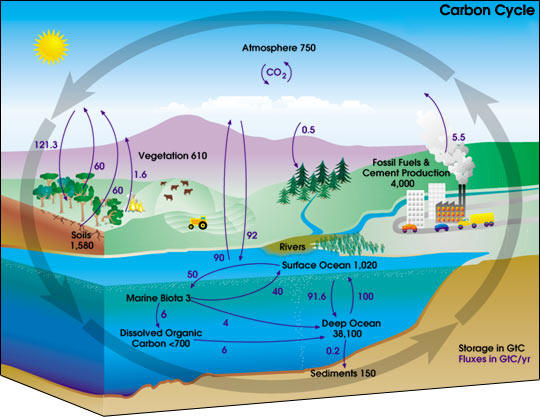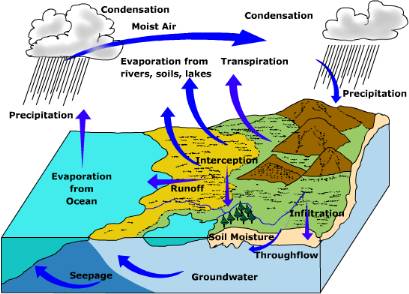Carbon CycleCarbon is the fourth most abundant element in the Universe and is the building block for all living things. The conversion of carbon dioxide into living matter and then back is the main pathway of the carbon cycle. Plants draw about one quarter of the carbon dioxide out of the atmosphere and photosynthesize it into carbohydrates. Some of the carbohydrate is consumed by plant respiration and the rest is used to build plant tissue and growth. Animals consume the carbohydrates and return carbon dioxide to the atmosphere during respiration. Carbohydrates are oxidized and returned to the atmosphere by soil microorganisms decomposing dead animal and plant remains (soil respiration). Another quarter of atmospheric carbon dioxide is absorbed by the world's oceans through direct air-water exchange. Surface water near the poles is cool and more soluble for carbon dioxide. The cool water sinks and couples to the ocean's thermohaline circulation which transports dense surface water toward the ocean's interior. Marine organisms form tissue containing reduced carbon, and some also form carbonate shells from carbon extracted from the air.
Figure 2.33 The Carbon Cycle
Video: Keeping Up With Carbon The Hydrologic CycleThe hydrologic cycle refers to the movement of water through its various stores within the Earth system. The amount of water that cycles between the surface and the atmosphere is phenomenal. At any minute, nearly a billion tons of water is delivered to the atmosphere by evaporation and the same amount precipitated from it. The hydrologic cycle not only traces the movement of water through the Earth system, it is a path way for the movement of energy. Water is evaporated from tropical oceans where energy is abundant and is transported on the wind to high latitudes where energy is in short supply. There it condenses and gives off heat to the atmosphere. The exchange of energy from low latitudes to high latitudes helps maintain the energy balance of the Earth system.
Figure 2.34 The Hydrologic Cycle The cycle starts with evaporation from the surface, most of which comes from the tropical oceans. The water vapor later condenses into clouds in which precipitation forms. Water falling as precipitation may be intercepted by vegetation or fall directly onto the surface. Water intercepted by plants may ultimately fall to the ground and seep into it. Likewise, water falling directly on the surface may seep into the subsurface or runoff to nearby streams. Water seeping into the ground may become soil water or groundwater. Water in the soil may be taken up by plants then transpired to the air. Groundwater may seep into streams or return to the ocean along along a coast. Water found in streams may also empty into the ocean. A detailed discussion of the hydrologic cycle is found in Chapter 10: "The Hydrosphere". |


